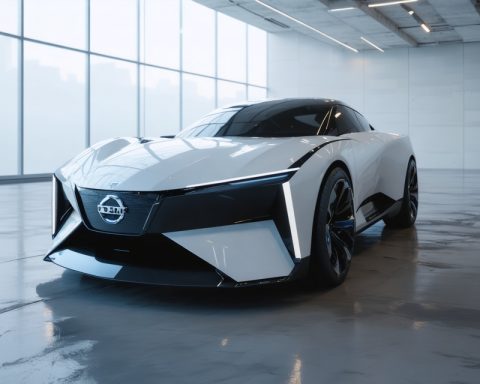- Electric vehicle (EV) market incentives have reached a record 14.8% of the average transaction price (ATP), roughly $8,162, the highest in over five years.
- This 44% increase in EV incentives from last year highlights a strong industry push towards electrification and making EVs more accessible.
- The average EV price in February was $55,273, marking a slight monthly decline but a 3.7% rise year-over-year, maintaining a 15.1% premium over the general market.
- Tesla’s average transaction prices rose by 1.8% year-over-year, with price fluctuations across different models, notably a 10% drop in the Cybertruck’s price month-over-month.
- Current high incentives present a significant opportunity for consumers, making EVs more affordable and appealing.
- The industry continues to focus on sustainability and value for consumers, signaling a transformative time for transitioning to green transportation.
The electric vehicle (EV) market has experienced a dramatic shift, with incentives skyrocketing to record levels. For electric car enthusiasts and potential buyers, this surge signals a transformative time. Incentives for purchasing new EVs have now climbed to a remarkable 14.8% of the average transaction price (ATP), amounting to approximately $8,162. This marks the highest level in over five years, reflecting the industry’s evolving landscape and the push towards electrification.
As the broader market hovers with incentives around 7% of ATP, EV incentives stand out, highlighting a more aggressive stance to attract buyers. A year ago, incentives for these eco-friendly vehicles were a modest 10.2%. This 44% increase underscores the industry’s drive to provide more accessible and attractive options for consumers considering an electric alternative.
Meanwhile, EV prices themselves present a complex narrative. February saw the average price for a new EV settle at $55,273, slightly down by 1.2% from the previous month, yet still showing a 3.7% rise year-over-year. When placed against the overall industry’s transaction price, which averaged $48,039, EVs maintain a 15.1% premium, slightly up from January.
Within this shifting marketplace, Tesla remains a beacon, yet not untouched. The pioneering brand saw its average transaction prices rise by 1.8% from the previous year to $53,248 in February, though they fell month-over-month as the industry maneuvered through demand changes. Notably, while prices for Tesla’s Model 3, Model Y, and the much-anticipated Cybertruck dropped, its Model S and Model X vehicles experienced upticks in price.
Observers noticed that the Cybertruck’s price, specifically, had tumbled more than 10% month-over-month, a recalibration as the novel vehicle began to settle into the wider spectrum of Tesla’s offerings. This volatility demonstrates the elasticity and dynamism characterizing the modern EV market.
For consumers considering the leap to an electric vehicle, this is a pivotal moment. The generous incentives present a golden opportunity, potentially making an impact on the affordability and appeal of EVs. Amidst these changes, the overarching industry objective remains clear: advancing toward a sustainable future while delivering value to consumers.
The central takeaway is one of informed opportunity. With the available incentives at historic highs, the path to owning an electric vehicle has never seemed more enticing. As the landscape continues to evolve, this is a prime chance for buyers to transition into a new era of transportation, underpinned by greener technologies and backed by compelling economic incentives.
In this era of change, it’s crucial to stay informed about the developments in the EV market, understanding both the short-term fluctuations and the long-term trends that will shape the future of mobility.
Why Now Is the Best Time to Consider an Electric Vehicle
The electric vehicle (EV) landscape is undergoing rapid transformation, primarily driven by generous incentives and evolving consumer trends. Not only do these incentives make EVs more accessible, but they also signal a monumental shift towards electrification. Let’s delve into what this means for potential EV buyers, the market trends, and the future of EVs.
Current Incentives and Market Dynamics
Understanding EV Incentives
With incentives for electric vehicles reaching a record 14.8% of the average transaction price (ATP), amounting to approximately $8,162, the financial appeal of investing in an EV has never been stronger. This level of support far surpasses the broader market incentives, which hover around 7% of ATP, emphasizing a strategic push to make EVs more appealing to consumers.
This significant 44% increase in incentives over the past year represents not just immediate savings but also a strategic move by manufacturers and governments to foster a more environmentally friendly automotive culture.
EV Pricing Trends and Challenges
While incentives are favorable, the average price for a new EV remains substantial at $55,273. Despite a dip of 1.2% from the previous month, this figure has risen by 3.7% over the past year. When compared to the overall industry’s average transaction price of $48,039, EVs still carry a premium of 15.1%. Key players such as Tesla have witnessed mixed pricing adjustments, with some models seeing price reductions and others experiencing upticks.
Market Forecasts and Industry Insights
Growth of EV Adoption
The trajectory for EV adoption looks bright, buoyed by supportive policies and heightened consumer interest. In the near future, experts anticipate more automakers launching EV lines, which should increase competition and potentially drive down prices further.
Infrastructure Developments
A burgeoning area to watch is the expansion of EV charging infrastructure. As more governments and private enterprises invest in this domain, the convenience and practicality of owning an EV are expected to improve significantly.
Real-World Use Cases and Consumer Considerations
Decoding the Value Proposition
Given the current incentives, potential EV buyers can:
– Reduce their initial purchase cost significantly.
– Anticipate lower long-term operating costs, thanks to reduced fuel expenses and maintenance compared to internal combustion engine vehicles.
Making an Informed Decision
When considering an EV, evaluate:
– Range and charging time: Ensure your chosen model meets your daily commuting needs.
– Total cost of ownership: Factor in fuel savings, potential tax credits, and maintenance costs.
– Availability of charging stations: Assess the infrastructure in your area to support your EV usage.
Pros and Cons Overview
Pros:
– Substantial incentives lowering the upfront cost.
– Lower long-term operational costs.
– Environmental benefits with zero tailpipe emissions.
Cons:
– Higher initial price despite incentives.
– Limited charging infrastructure in certain areas.
– Longer refueling (charging) times compared to gasoline vehicles.
Industry Trends and Predictions
The Road Ahead
EV production is expected to diversify in the coming years to include a wider array of models and features. As battery technology advances and production scales up, the costs associated with EVs should decline, making them even more competitive with traditional vehicles.
Conclusion and Recommendations
For consumers, this is an opportune moment to consider the shift to electric vehicles. Not only can you take advantage of unprecedented incentives, but you are also contributing to a sustainable future.
Quick Tips:
1. Research available incentives in your region.
2. Test drive electric vehicles to become familiar with the driving experience.
3. Stay updated on new models and features coming to market.
For more insights and updates on electric vehicles, explore developments from leading manufacturers, automakers, and industry experts at Car and Driver and MotorTrend.














